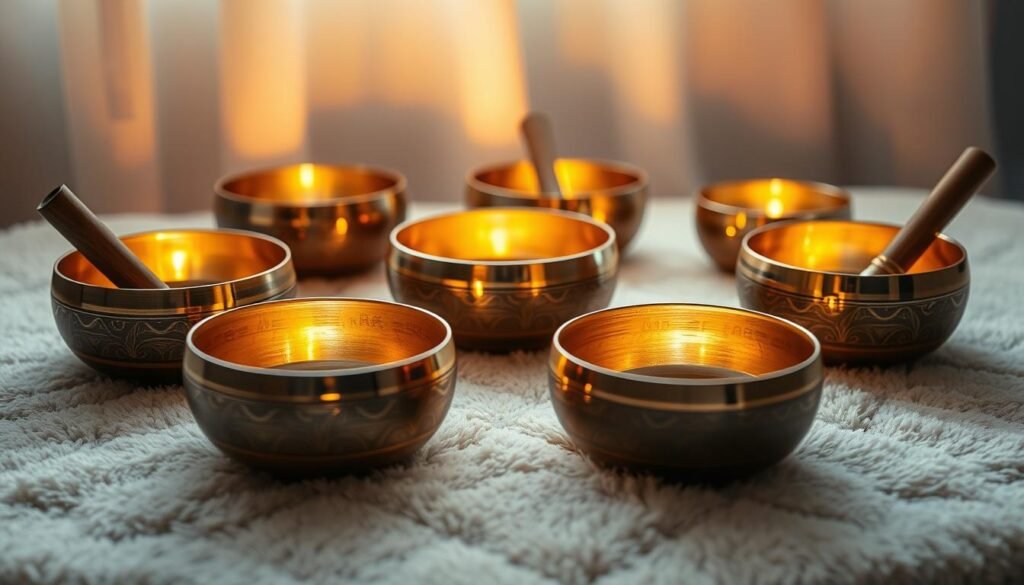
Are you tired of lying awake at night, struggling to drift off into a restful slumber? Could the soothing sounds of singing bowls be the key to unlocking deeper sleep?
For centuries, singing bowls have been used in meditation and healing practices. Their calming tones can be a powerful tool for improving sleep quality. By adding singing bowls to your bedtime routine, you can create a peaceful atmosphere. This fosters relaxation and rejuvenation.
In this comprehensive guide, we explore how singing bowls can help you achieve a more restful and rejuvenating sleep. We’ll discuss the benefits of using singing bowls for sleep. You’ll learn how to choose the right one and techniques for incorporating them into your bedtime routine.
Key Takeaways
- Discover the benefits of using singing bowls for improved sleep quality
- Learn how to choose the right singing bowl for your needs
- Explore techniques for incorporating singing bowls into your bedtime routine
- Understand how singing bowls can help reduce stress and anxiety
- Create a peaceful sleep environment with singing bowls
What Are Singing Bowls and Their Origins?
Singing bowls come from ancient Tibetan and Buddhist traditions. They are more than just musical instruments. They play a key role in meditation, healing, and spiritual practices.
The History of Singing Bowls
Singing bowls started in the Himalayan region. They were used in traditional Tibetan and Buddhist ways. Their history goes back thousands of years, used in ancient rituals and ceremonies.
These bowls were thought to have healing powers. They were believed to balance the body’s energy and help with spiritual growth.
In the Himalayan communities, singing bowls were a big part of culture and spirituality. Monks and healers used them in meditation. They believed the sounds could heal the mind, body, and spirit.
Different Materials Used in Singing Bowls
Singing bowls are made from bronze, brass, and crystal. Each material makes a different sound and vibration. The material affects the bowl’s tone and resonance.
For example, bronze bowls have deep tones. Crystal bowls sound like bells. The material also affects the bowl’s durability and looks.
Cultural Significance in Meditation
In Tibetan and Buddhist cultures, singing bowls are sacred. They help with meditation and spiritual growth. The sound they make helps people relax and find inner peace.
Singing bowls are also used in rituals and ceremonies. They help with healing and balance. Knowing their cultural background can make them more effective for sleep and relaxation.
Understanding the history and cultural importance of singing bowls can improve their use. It can make relaxation and sleep better.
The Science Behind Sound and Sleep
Sound healing, like using singing bowls, is based on science. It shows how it can improve our sleep. Singing bowls are popular for helping people sleep better.
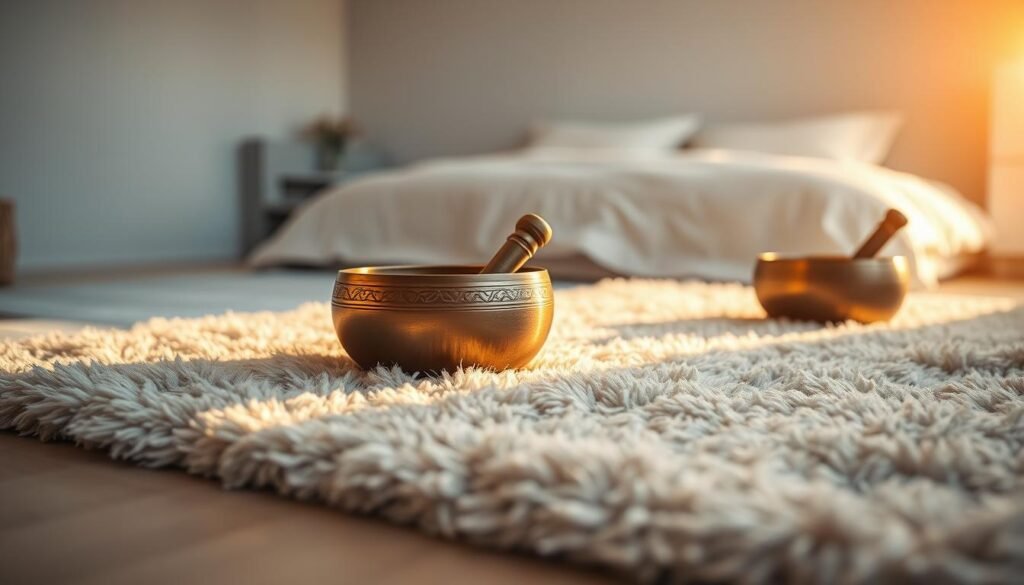
How Sound Waves Affect the Brain
Singing bowls’ sound waves calm the brain and reduce stress. When we listen to their soothing sounds, our brain slows down. This helps us move from being alert to being calm.
This change is due to brainwave entrainment. It’s when our brain syncs with external sounds, like singing bowls. This helps us relax.
Sound Frequencies and Relaxation
Different sounds affect us in different ways. Singing bowls create sounds that help us relax and sleep. Lower sounds calm the mind, while higher sounds help us meditate.
Sound healing has been used for centuries. Using singing bowls for sleep is a natural way to improve it.
Research on Sound Healing
Research on sound healing is promising. It shows sound healing can help with insomnia and improve sleep. It also makes sleep better overall.
More studies are needed to fully understand sound healing. But, the current evidence supports using singing bowls for sleep issues.
In summary, sound healing with singing bowls is backed by science. It shows how sound affects the brain and improves sleep. Using singing bowls can help us sleep deeper and more restfully.
Choosing the Right Singing Bowl for Sleep
Finding the right singing bowl is key to better sleep. There are many options, so it’s important to think about what you need.
Size and Tone Considerations
The size and tone of a singing bowl affect its sound and sleep benefits. Larger bowls make deeper sounds, which are better for relaxing. Smaller bowls have higher pitches, not as good for sleep.
Size and Tone Guide:
| Size | Tone | Sleep Effectiveness |
|---|---|---|
| Small (less than 8 inches) | High-pitched | Less effective for deep sleep |
| Medium (8-12 inches) | Medium tone | Moderately effective |
| Large (over 12 inches) | Deep tone | Highly effective for deep sleep |
Popular Brands for Beginners
For beginners, some brands are known for quality and price. These include:
- Singing Bowl Store
- Meditation Instruments
- Sound Healing Center
These brands have singing bowls great for bedtime routines.
Where to Purchase Authentic Singing Bowls
It’s important to buy from trusted places to get a real singing bowl. You can find them at:
- Specialty meditation stores
- Online marketplaces like Amazon
- Local craft fairs or spiritual shops

Think about size and tone, look at popular brands, and buy from trusted sources. This way, you’ll find the best singing bowl for better sleep.
Preparing Your Environment for Relaxation
Before you start using singing bowls for sleep, it’s vital to create a calming environment. This environment should help you relax and prepare for a good night’s sleep.
Creating a Calming Atmosphere
A calming atmosphere is key for relaxation. Think about your bedroom or meditation space’s look. Minimize clutter to make the space feel serene and welcoming. Use soft, soothing colors and comfy textiles to create a calming vibe.
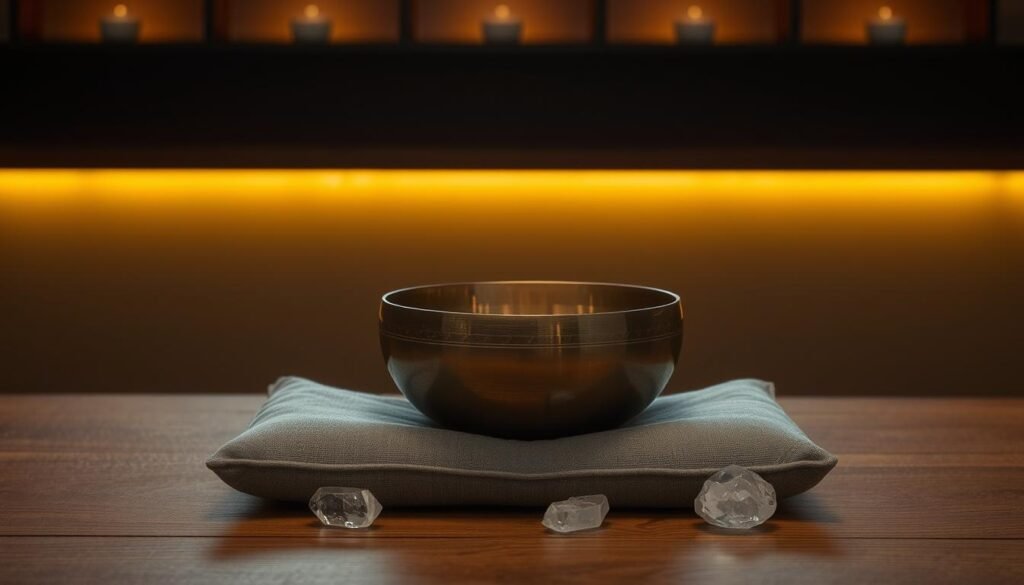
Optimal Lighting and Scents
Lighting and scents are important for setting a relaxing mood. Dim, warm lighting tells your brain it’s time to relax. Use candles or a dimmer switch for the right feel. Also, scents like lavender and vanilla can calm you down. Use essential oils or scented candles to add these scents.
| Lighting Option | Effect on Relaxation |
|---|---|
| Dim, Warm Lighting | Promotes relaxation and reduces eye strain |
| Bright, Cool Lighting | Can be stimulating and interfere with sleep |
Minimizing Distractions
To get the most from singing bowl therapy, reduce distractions. Turn off electronics, find a quiet spot, and stick to a relaxing routine. This tells your brain it’s time to unwind.
- Turn off notifications on your phone or put it on silent mode.
- Use earplugs or white noise machines if necessary to block out background noise.
- Inform family members or roommates of your relaxation routine to minimize interruptions.
By preparing your environment well, singing bowls can help you sleep deeper and relax more.
Techniques to Use Singing Bowls Before Sleep
Learning how to use singing bowls can make your bedtime routine better. Adding these techniques to your evening can help you sleep better and feel more refreshed in the morning.
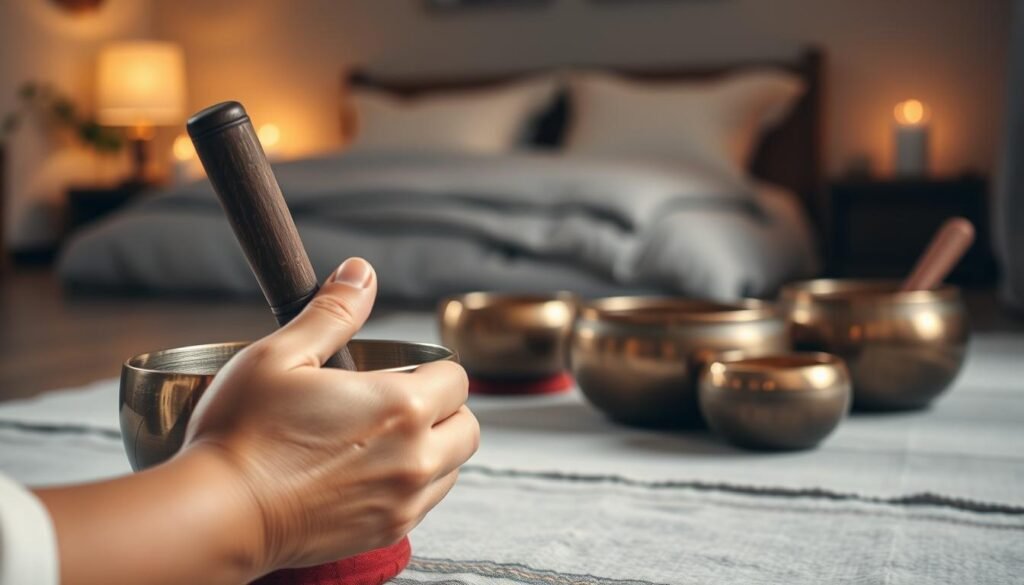
Simple Playing Techniques for Beginners
If you’re new to singing bowls, start with easy techniques. Hold the bowl in your hand or on a cushion to keep it steady. Use a mallet to strike the bowl, then move it around the rim for a continuous sound. Try different speeds and pressures to find your favorite tone.
- Start with a gentle strike to awaken the bowl’s tone.
- Gradually increase the pressure around the rim for a deeper sound.
- Practice different strokes to vary the sound produced.
Incorporating Breathing Exercises
Using singing bowls with breathing exercises can make you relax more. Play the bowl and breathe in sync with the sound. Breathe in as the sound grows, and breathe out as it fades. This can calm your mind and body for sleep.
- Inhale for a count of 4 as the sound begins.
- Hold your breath for a count of 2 at the sound’s peak.
- Exhale for a count of 4 as the sound fades.
Guided Meditation with Singing Bowls
Guided meditation with singing bowls uses the sound to focus your mind. Listen to the sound and let it guide you into deep relaxation. You can use pre-recorded meditations or let the bowl’s sound lead your practice.
Tips for effective guided meditation:
- Find a quiet, comfortable space to meditate.
- Use the singing bowl’s sound as your focal point.
- Allow yourself to fully immerse in the relaxation.
By adding these techniques to your evening, you can enjoy the benefits of singing bowls for sleep and improve your well-being.
Timing Your Singing Bowl Session
Getting the timing right for your singing bowl practice is crucial for better sleep. The success of singing bowls in enhancing sleep quality depends on when and how you use them. By focusing on the right session length, the best practice time, and integrating singing bowls into your bedtime routine, you can enhance your sleep.
Ideal Duration for Relaxation
The length of your singing bowl session greatly affects its outcome. Studies show that sessions between 15 to 30 minutes are best for relaxation. This duration helps your mind and body relax, making it easier to fall asleep.
Recommended Session Lengths:
- Beginners: 5-10 minutes
- Regular practitioners: 15-30 minutes
- Advanced users: 30-45 minutes
Best Time of Day to Practice
Evening is the best time to use singing bowls, about 30 minutes to 1 hour before bed. This timing tells your body it’s time to sleep, making it easier to fall and stay asleep.
| Time of Day | Benefits |
|---|---|
| Morning | Boosts energy and sets a positive tone for the day |
| Evening | Promotes relaxation and prepares the body for sleep |
| Anytime | Can be used during stressful moments for immediate relaxation |
Pairing with Bedtime Routines
Adding singing bowl practice to your bedtime routine can make it more effective. Mix your singing bowl session with relaxing activities like reading, meditation, or a warm bath. This creates a soothing pre-sleep routine.
Tips for a Relaxing Bedtime Routine:
- Dim the lights to signal to your body that it’s time to sleep
- Use comfortable, calming scents like lavender
- Avoid screens for at least an hour before bedtime

By timing your singing bowl sessions right and adding them to a consistent bedtime routine, you can greatly improve your sleep. Try different lengths and times to see what works best for you.
How to Play a Singing Bowl Effectively
To get the most out of your singing bowl, it’s essential to learn the proper techniques for playing it. Playing a singing bowl effectively can enhance your singing bowl meditation for better sleep and help you incorporate singing bowls in your bedtime routine seamlessly.
Proper Holding and Striking Techniques
Holding the singing bowl correctly is crucial for producing a clear, resonant sound. Hold the bowl in the palm of your hand or on a cushion, depending on its size. To strike the bowl, use a mallet with a gentle, firm motion. Experiment with different striking forces to find the sound that works best for you.

Creating Harmonious Sounds
The sound produced by a singing bowl is not just about the bowl itself, but also how you play it. To create harmonious sounds, focus on the rim of the bowl and use a smooth, consistent motion with your mallet. The speed and pressure of your strokes can significantly affect the quality of the sound.
Experimenting with Different Strokes
Don’t be afraid to experiment with different playing techniques. Try varying the speed, pressure, and direction of your strokes to discover the range of sounds your bowl can produce. This experimentation can help you tailor your singing bowl experience to your personal preferences and needs.
By mastering these techniques, you can enhance your singing bowl practice, making it a more effective tool for relaxation and sleep improvement.
Enhancing Your Experience with Additional Tools
To make your singing bowl practice better, try adding tools that help you relax. These extras can make your experience more immersive and calming. This can help you unwind and get ready for a good night’s sleep.
Meditation Cushions or Mats
Meditation cushions or mats can make your singing bowl sessions more comfortable. They support your posture, letting you relax and focus on the sound. Choose cushions or mats from natural materials for the best support and comfort.
Benefits of Meditation Cushions or Mats:
- Improved posture support
- Enhanced comfort during meditation
- Better focus on the singing bowl sounds
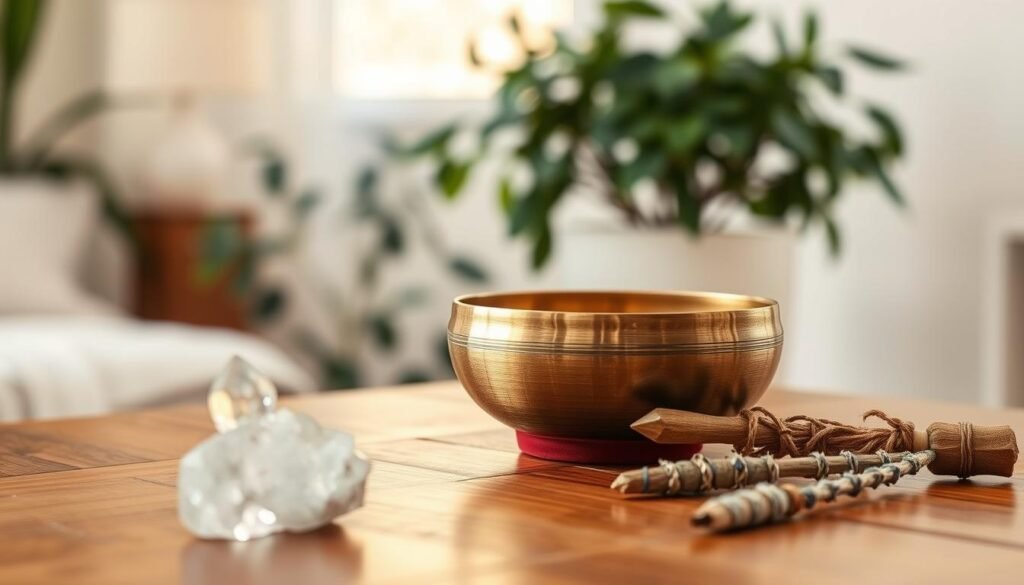
Essential Oils and Aromatherapy
Adding essential oils and aromatherapy to your singing bowl practice can help you relax more. Scents like lavender and chamomile are calming. Use a diffuser or apply essential oils to your skin to create a soothing atmosphere.
| Essential Oil | Benefit |
|---|---|
| Lavender | Promotes calmness and relaxation |
| Chamomile | Soothes the mind and body |
| Frankincense | Reduces anxiety and stress |
Combining with Other Sound Healing Instruments
Using singing bowls with other sound healing tools can make your experience richer. Tools like tuning forks, gongs, or chimes can add to the therapy. Try different combinations to see what works best for you.
Tips for Combining Instruments:
- Start with one instrument and add more
- Try different sound frequencies and volumes
- Notice how the sounds make you feel
Adding these tools to your singing bowl practice can make it better. Whether you use meditation cushions, essential oils, or other instruments, the goal is to create a practice that suits you. This way, you can relax and sleep better.
Overcoming Common Challenges
Singing bowls can greatly improve sleep, but users face some hurdles. To get the most out of singing bowls, it’s important to tackle common problems.
Troubleshooting Sound Issues
Getting the right sound from singing bowls is a big concern. If the sound is unclear, it might be the bowl’s size, material, or how you play it. Try different striking techniques or mallets to improve the sound. Also, make sure the bowl is clean and free of dust to boost its resonance.
Regular maintenance of your singing bowl, like polishing it gently, can also improve the sound. If sound issues persist, seek advice from a sound healing expert or try different bowls to find the right one for you.
Managing Distractions During Use
It’s vital to have a quiet, comfortable space for singing bowl practice. Choose a spot where you can relax without distractions. Using meditation cushions or mats can also help create a peaceful atmosphere.
Also, turn off electronic distractions like notifications or use white noise machines. Adding elements like aromatherapy or soft lighting can make the environment even more relaxing, helping you focus on your practice.
Staying Consistent with Your Practice
Consistency is crucial for enjoying singing bowls’ benefits. Make a regular practice routine, even if it’s just a few minutes a day. Setting realistic goals and tracking your progress can also keep you motivated.
Combining singing bowl practice with other relaxation methods, like deep breathing or guided meditation, can make it more consistent. By making singing bowl practice a daily habit, you can fully enjoy its sleep-improving benefits.

Testimonials and Success Stories
Many people have found singing bowls help them sleep better. They say they wake up feeling more refreshed. Singing bowl meditation is becoming a favorite way to improve sleep.
Real-Life Experiences
Those who use singing bowls before bed sleep better. They find it easier to relax and fall asleep. This leads to a more regular sleep pattern.
Expert Insights
Sound healing experts also see the benefits of singing bowls for sleep. They suggest using singing bowls to calm the mind. This can help you relax and sleep better.
Share Your Story
We invite you to share how singing bowls have helped you sleep. Your story can inspire others to try singing bowls for better sleep.
